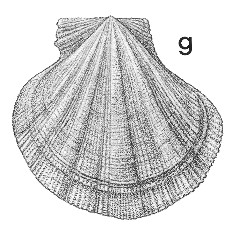
Revised descriptions of New Zealand Cenozoic Mollusca from Beu and Maxwell (1990)

 | Revised descriptions of New Zealand Cenozoic Mollusca from Beu and Maxwell (1990) | 
|
  (Pl. 44g): Castlecliff, Wanganui, Castlecliffian (GNS, from old collection), left valve with tip of left ear broken, |
Beu & Maxwell (1990): Chapter 16; p. 338; pl. 44 g.
Synonymy: Pecten convexus Quoy & Gaimard 1835, p. 443; Pecten kapitiensis Mestayer 1929, p. 249; Pallium convexum; Pallium (Mesopeplum) convexum; Pallium (Felipes) convexum
Classification: Pectinidae
Description: Small for family (to 60 mm high), thick and solid, well inflated, exceedingly variable in sculpture. All specimens have 4 or 5 (6 in a few specimens) prominent radial folds in disc; superimposed on and between folds are about 35 to 50 closely spaced, narrow radial costae, varying from many scarcely discernible fine threads (so shell appears almost smooth) to fewer, coarser, well raised costae of square cross-section. Two valves almost equally inflated; anterior ear of each valve much larger than posterior one; right valve with small but obvious byssal notch and short, finely toothed ctenolium. No hinge teeth or other obvious internal characters other than simple pallial line and large, circular adductor scar.
Comparison: The range of variation of fossil taxa of Mesopeplum is in need of further study, and the number of valid species, and their time ranges, are unclear. Early-mid Cenozoic populations seem consistently to be relatively coarsely sculptured and apparently represent the distinct species M. burnetti (Zittel, 1864). Modern specimens are exceedingly variable in the number and size of radial folds, the number and prominence of radial costae, the inflation and growth steps of the disc, and the shape of the disc. It seems possible that named extreme forms such as M. syagrus and M. waikohuense are also part of the variation of M. convexum, but it is more likely that they are distinct species. Some similar but smaller and more finely ribbed species occur in northern New Zealand Early Miocene rocks (M. costatostriatum, M. kaiparaense, both Otaian-Altonian of Kaipara Harbour); the larger M. dendyi (early Pliocene, Chatham Islands; Pl. 32b, g) is illustrated also.
Despite the shallow but apparently functional byssal notch, adults lie unattached on clean, firm sand or gravel, offshore in about 20 to 80 m (and rarely deeper), and are the most actively swimming of modern New Zealand pectens, leaping about and "clapping" their valves actively when dredged.
Distribution: (Kaiatan?-) Duntroonian-Recent. Recent, New Zealand (types of Pecten convexus and Pecten kapitiensis ); "Motupipi, Massacre Bay, Province of Nelson", i.e., Tarakohe Limestone, Takaka, west of Nelson, Waitakian (type of Pecten burnetti), probably a distinct species. Fossils are common to abundant in sandstone and, particularly, coquina limestone (e.g., Castlepoint, Wairarapa, Nukumaruan; Patutahi Limestone, Gisborne, Tongaporutuan; Takaka Limestone, Tarakohe, northwest Nelson, Waitakian), rocks that formed in high-energy environments on the middle shelf. The earliest specimen of this type we are aware of is from Point Elizabeth-Rapahoe Beach, north of Greymouth (Kaiata Mudstone, Kaiatan). Specimens occur rather rarely in Eocene and Oligocene rocks, but are locally common in high-energy facies throughout New Zealand at all ages after Oligocene time.
Cite this publication as: "A.G. Beu and J.I. Raine (2009). Revised
descriptions of New Zealand Cenozoic Mollusca from Beu and Maxwell (1990). GNS
Science miscellaneous series no. 27."
© GNS Science, 2009
ISBN
978-0-478-19705-1
ISSN 1177-2441
(Included with a PDF facsimile file
copy of New Zealand Geological Survey Paleontological Bulletin 58 in CD version
from: Publications Officer, GNS Science, P.O. Box 30368 Lower Hutt, New
Zealand)